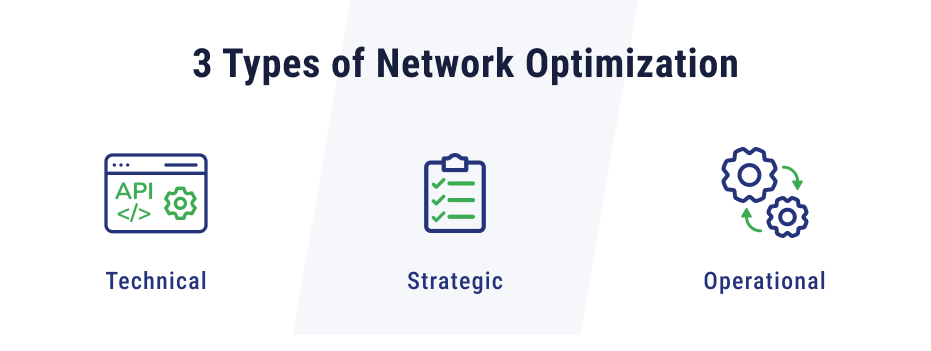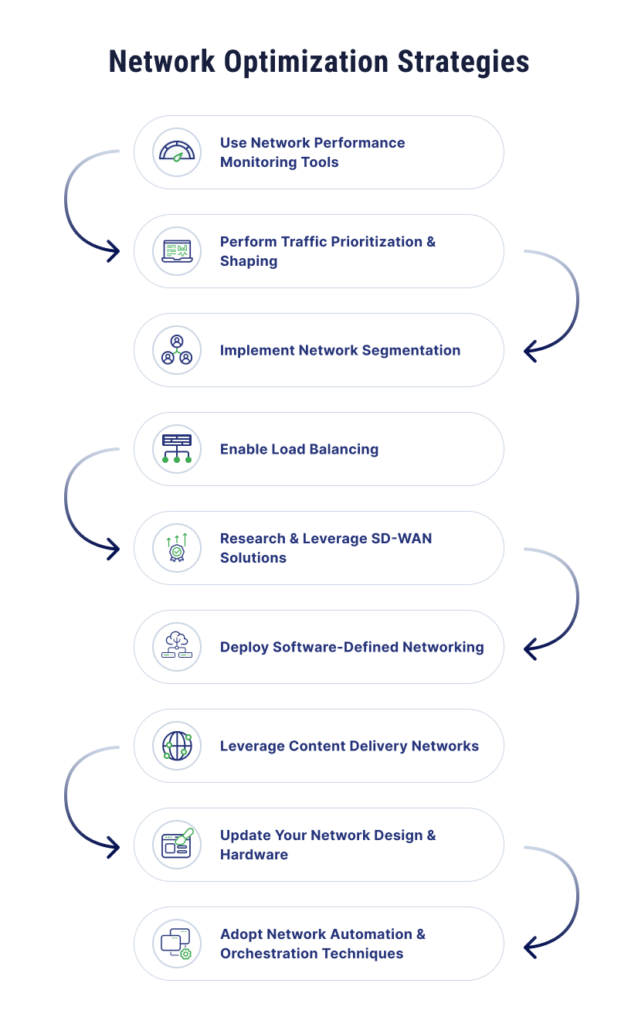
Has network downtime or performance issues hindered your team’s productivity? Have users complained about latency problems and lagging applications? If so, it may be time to look at network optimization strategies. By implementing these 9 network optimization techniques, businesses can improve the performance of their networks, unlocking its full potential and uncovering opportunities for improvement.
What is Network Optimization?
The goal of network optimization is to allow data to flow smoothly and efficiently across your network. When businesses engage in network optimization, they are applying processes to improve the reliability and performance of their networks to meet the growing and changing demands of applications and users alike.
Types of Network Optimization
There are three main types of network optimization – technical, strategic, and operational.

- Technical optimization: Hardware upgrades, traffic shaping, and bandwidth allocation are all technical aspects of a network that could be improved.
- Strategic optimization: What are you trying to achieve? By applying strategic optimization, you start with your goals in mind and work backwards to design your network to meet these objectives. These might include goals for network performance, business needs related to network traffic, and security and efficiency goals that could be solved with network segmentation.
- Operational optimization: Sometimes, it’s less about the hardware and more about the tools and techniques used to streamline tasks and automations. Performance monitoring, automation scripts, and configuration management can all be part of operational optimization that improves network health and reduces the manual tasks IT staff need to perform to keep the network running smoothly.
Why is it Important to Optimize Your Network?
Your network serves as your traffic command center for users and internal teams. A well-optimized network can greatly improve the user experience and the productivity of your workforce.
An optimized network can improve productivity and user experience. Without it, users can struggle with slow loading times, frequent outages, or application delays that can result in frustration or even abandoning the tools altogether.
Network performance optimization can also increase efficiency through techniques like traffic shaping and network segmentation. The end result is a more streamlined operation, boosting the value from your existing network infrastructure and improving performance. Efficiencies also reduce costs by increasing productivity, reducing downtime, and making the most of current resources.
Often, when businesses evaluate their network performance, optimization processes also call for revisiting access controls and security protocols. Well-optimized networks are often more secure than ones that haven’t been assessed in a while.
Optimizing networks can also enable scalability and allow for future-proofing. Networks can accommodate increasing workloads and bandwidth requirements when they’re optimized.
Is it Time to Perform Network Optimization?
Are you relatively happy with your network performance? Are issues starting to creep in? Here’s how you can determine whether it’s time to perform network optimization measures.
Are You Experiencing Network Performance Issues?
You may experience one or several symptoms indicative of a need to optimize your networks. Application slowdowns, lagging user experience, increased latency, data transfer delays, and network congestion can all be symptoms of a bigger problem. These can be signs of bandwidth limitations, network congestion, or less-than-ideal resource allocation.
Are Your Workloads Growing?
As your workload sizes increase, bandwidth demands will also grow. High-performance computing, such as artificial intelligence and machine learning (AI/ML), are more demanding workloads that require substantial bandwidth. If you are starting to incorporate these technologies into your infrastructure, you need to ensure that your network can meet increased demands.
Tips and Strategies for Network Optimization
Network optimization can be done by employing one or more strategies to improve performance, increase efficiencies, and decrease roadblocks and latency.

Use Network Performance Monitoring Tools
To ensure optimal network performance and proactively identify potential issues, leveraging dedicated network performance monitoring tools is essential. These tools provide real-time visibility into your network’s health, allowing you to pinpoint bottlenecks or underlying problems that could be degrading the end-user experience.
By tapping into hypervisor or hyperscaler integrated reporting metrics, as well as log analytics and agent-based monitoring systems, you can gain comprehensive insights into your network’s behavior. Additionally, vendor-integrated monitoring solutions and protocols like syslog and NetFlow can offer granular data on network traffic patterns and resource utilization. With these powerful monitoring and optimization tools at your disposal, you can stay ahead of performance challenges and ensure your network consistently delivers the level of service your business demands.
Perform Traffic Prioritization and Shaping
Not all traffic needs to be at the front of the queue. Quality of service (QoS) prioritizes applications based on importance, controlling traffic and ensuring the urgent workloads operate at their peak. This could mean that financial transactions are prioritized over a task such as bulk data transfers. Traffic shaping can build on QoS by aligning bandwidth allocation to current priorities.
Implement Network Segmentation
One large network can pose a greater security risk than one that is segmented. Dividing your network into smaller segments can also improve performance. You may consider separating guest traffic from internal workloads, or separate high-bandwidth activities from the rest of your processes.
Enable Load Balancing
Having all traffic relegated to one area can place a strain on your network. Consider enabling load balancing instead. You can distribute network traffic across several connections or servers to avoid overloading individual resources. This can optimize application performance and provide a better end-user experience.
Research and Leverage SD-WAN Solutions
Software-defined Wide Area Networks (SD-WAN) can connect local area networks (LANs) using software-defined networking (SDN) principles. These then become wide-area networks (WAN), where networks are connected across geographically dispersed locations.
With SD-WAN, businesses can apply intelligent traffic routing, as well as application awareness, to their networks and streamline their WAN connectivity, improving performance. Approximately 43% of respondents to LiveAction’s 2024 Network Performance Monitoring Trends Report are managing either WAN or SD-WAN networks.
Deploy Software-Defined Networking
With SDN, the control plane is centralized, allowing for more programmatic configuration and automation of networks. While this involves additional configuration, SDN can make networks more flexible and simple to manage and optimize.
Leverage Content Delivery Networks
Content delivery networks (CDNs) can improve performance for geographically distributed users or applications that may be content-heavy. CDNs store content, not just in one place, but on dispersed servers, to reduce latency for users and improve their experience when accessing data.
Update Your Network Design and Hardware
When network hardware is outdated, it can create a drag on performance. Upgrade old hardware and revisit your network design to better align with network needs. Network modernization can also optimize your data flow. A choice that was once efficient may prove inefficient over time as more gets added to the network.
Adopt Network Automation and Orchestration Techniques
The more you are able to automate manual tasks, the more time you will free up for your IT teams, allowing them to focus on more strategic, interesting initiatives. Automation can also reduce the risk of manual errors and improve the efficiency of operating your network. According to LiveAction, many organizations are still overly reliant on manual processes and could stand to benefit from automation technology.
Building a Continuous Network Performance Monitoring Plan
As a best practice to keep your network performance running properly, businesses should build an ongoing plan to monitor and optimize their networks. If you’re not sure what to include in your plan, or you’re looking for a partner to work alongside your team, TierPoint is here to help. Learn more about our IT Network Services and chat with our experts today.

